Liu He
Exploring Gender Bias in Alzheimer's Disease Detection: Insights from Mandarin and Greek Speech Perception
Jul 16, 2025Abstract:Gender bias has been widely observed in speech perception tasks, influenced by the fundamental voicing differences between genders. This study reveals a gender bias in the perception of Alzheimer's Disease (AD) speech. In a perception experiment involving 16 Chinese listeners evaluating both Chinese and Greek speech, we identified that male speech was more frequently identified as AD, with this bias being particularly pronounced in Chinese speech. Acoustic analysis showed that shimmer values in male speech were significantly associated with AD perception, while speech portion exhibited a significant negative correlation with AD identification. Although language did not have a significant impact on AD perception, our findings underscore the critical role of gender bias in AD speech perception. This work highlights the necessity of addressing gender bias when developing AD detection models and calls for further research to validate model performance across different linguistic contexts.
MMIG-Bench: Towards Comprehensive and Explainable Evaluation of Multi-Modal Image Generation Models
May 26, 2025Abstract:Recent multimodal image generators such as GPT-4o, Gemini 2.0 Flash, and Gemini 2.5 Pro excel at following complex instructions, editing images and maintaining concept consistency. However, they are still evaluated by disjoint toolkits: text-to-image (T2I) benchmarks that lacks multi-modal conditioning, and customized image generation benchmarks that overlook compositional semantics and common knowledge. We propose MMIG-Bench, a comprehensive Multi-Modal Image Generation Benchmark that unifies these tasks by pairing 4,850 richly annotated text prompts with 1,750 multi-view reference images across 380 subjects, spanning humans, animals, objects, and artistic styles. MMIG-Bench is equipped with a three-level evaluation framework: (1) low-level metrics for visual artifacts and identity preservation of objects; (2) novel Aspect Matching Score (AMS): a VQA-based mid-level metric that delivers fine-grained prompt-image alignment and shows strong correlation with human judgments; and (3) high-level metrics for aesthetics and human preference. Using MMIG-Bench, we benchmark 17 state-of-the-art models, including Gemini 2.5 Pro, FLUX, DreamBooth, and IP-Adapter, and validate our metrics with 32k human ratings, yielding in-depth insights into architecture and data design. We will release the dataset and evaluation code to foster rigorous, unified evaluation and accelerate future innovations in multi-modal image generation.
Leveraging Cascaded Binary Classification and Multimodal Fusion for Dementia Detection through Spontaneous Speech
May 26, 2025
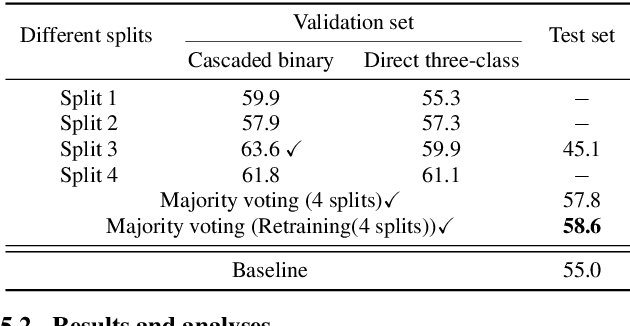
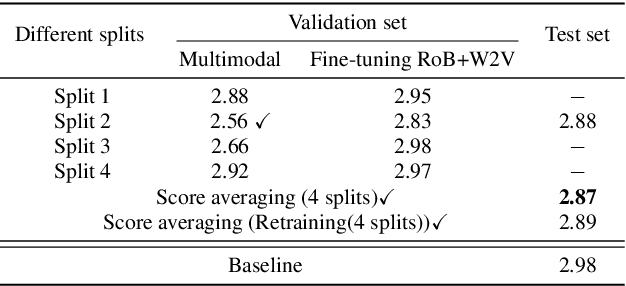
Abstract:This paper presents our submission to the PROCESS Challenge 2025, focusing on spontaneous speech analysis for early dementia detection. For the three-class classification task (Healthy Control, Mild Cognitive Impairment, and Dementia), we propose a cascaded binary classification framework that fine-tunes pre-trained language models and incorporates pause encoding to better capture disfluencies. This design streamlines multi-class classification and addresses class imbalance by restructuring the decision process. For the Mini-Mental State Examination score regression task, we develop an enhanced multimodal fusion system that combines diverse acoustic and linguistic features. Separate regression models are trained on individual feature sets, with ensemble learning applied through score averaging. Experimental results on the test set outperform the baselines provided by the organizers in both tasks, demonstrating the robustness and effectiveness of our approach.
Building-Block Aware Generative Modeling for 3D Crystals of Metal Organic Frameworks
May 13, 2025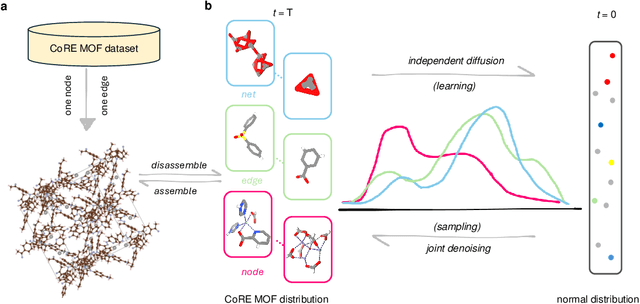
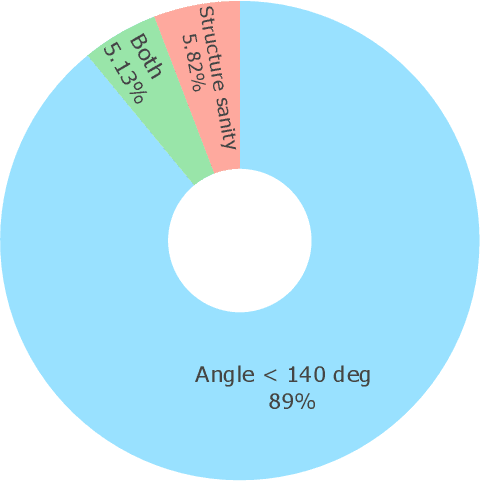
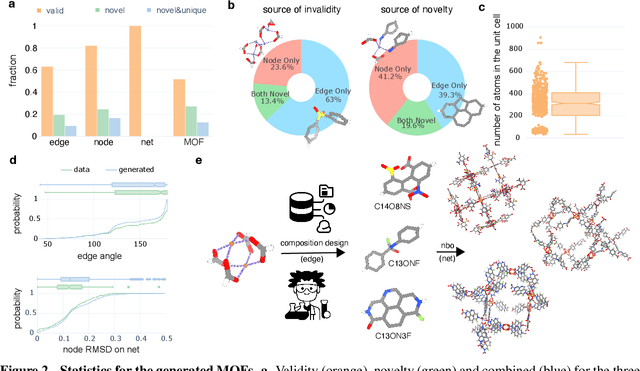
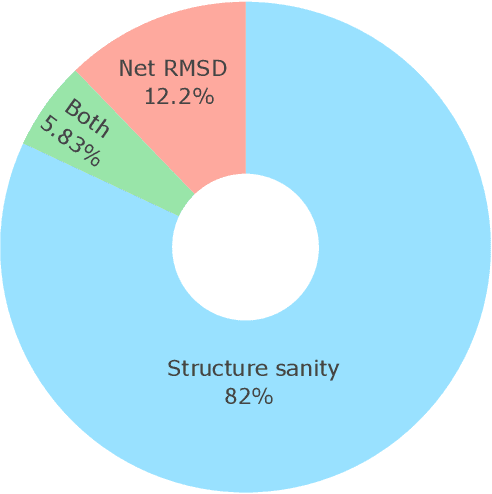
Abstract:Metal-organic frameworks (MOFs) marry inorganic nodes, organic edges, and topological nets into programmable porous crystals, yet their astronomical design space defies brute-force synthesis. Generative modeling holds ultimate promise, but existing models either recycle known building blocks or are restricted to small unit cells. We introduce Building-Block-Aware MOF Diffusion (BBA MOF Diffusion), an SE(3)-equivariant diffusion model that learns 3D all-atom representations of individual building blocks, encoding crystallographic topological nets explicitly. Trained on the CoRE-MOF database, BBA MOF Diffusion readily samples MOFs with unit cells containing 1000 atoms with great geometric validity, novelty, and diversity mirroring experimental databases. Its native building-block representation produces unprecedented metal nodes and organic edges, expanding accessible chemical space by orders of magnitude. One high-scoring [Zn(1,4-TDC)(EtOH)2] MOF predicted by the model was synthesized, where powder X-ray diffraction, thermogravimetric analysis, and N2 sorption confirm its structural fidelity. BBA-Diff thus furnishes a practical pathway to synthesizable and high-performing MOFs.
LongPerceptualThoughts: Distilling System-2 Reasoning for System-1 Perception
Apr 21, 2025Abstract:Recent reasoning models through test-time scaling have demonstrated that long chain-of-thoughts can unlock substantial performance boosts in hard reasoning tasks such as math and code. However, the benefit of such long thoughts for system-2 reasoning is relatively less explored in other domains such as perceptual tasks where shallower, system-1 reasoning seems sufficient. In this paper, we introduce LongPerceptualThoughts, a new synthetic dataset with 30K long-thought traces for perceptual tasks. The key challenges in synthesizing elaborate reasoning thoughts for perceptual tasks are that off-the-shelf models are not yet equipped with such thinking behavior and that it is not straightforward to build a reliable process verifier for perceptual tasks. Thus, we propose a novel three-stage data synthesis framework that first synthesizes verifiable multiple-choice questions from dense image descriptions, then extracts simple CoTs from VLMs for those verifiable problems, and finally expands those simple thoughts to elaborate long thoughts via frontier reasoning models. In controlled experiments with a strong instruction-tuned 7B model, we demonstrate notable improvements over existing visual reasoning data-generation methods. Our model, trained on the generated dataset, achieves an average +3.4 points improvement over 5 vision-centric benchmarks, including +11.8 points on V$^*$ Bench. Notably, despite being tuned for vision tasks, it also improves performance on the text reasoning benchmark, MMLU-Pro, by +2 points.
Caption Anything in Video: Fine-grained Object-centric Captioning via Spatiotemporal Multimodal Prompting
Apr 09, 2025Abstract:We present CAT-V (Caption AnyThing in Video), a training-free framework for fine-grained object-centric video captioning that enables detailed descriptions of user-selected objects through time. CAT-V integrates three key components: a Segmenter based on SAMURAI for precise object segmentation across frames, a Temporal Analyzer powered by TRACE-Uni for accurate event boundary detection and temporal analysis, and a Captioner using InternVL-2.5 for generating detailed object-centric descriptions. Through spatiotemporal visual prompts and chain-of-thought reasoning, our framework generates detailed, temporally-aware descriptions of objects' attributes, actions, statuses, interactions, and environmental contexts without requiring additional training data. CAT-V supports flexible user interactions through various visual prompts (points, bounding boxes, and irregular regions) and maintains temporal sensitivity by tracking object states and interactions across different time segments. Our approach addresses limitations of existing video captioning methods, which either produce overly abstract descriptions or lack object-level precision, enabling fine-grained, object-specific descriptions while maintaining temporal coherence and spatial accuracy. The GitHub repository for this project is available at https://github.com/yunlong10/CAT-V
Generative AI for Cel-Animation: A Survey
Jan 08, 2025Abstract:Traditional Celluloid (Cel) Animation production pipeline encompasses multiple essential steps, including storyboarding, layout design, keyframe animation, inbetweening, and colorization, which demand substantial manual effort, technical expertise, and significant time investment. These challenges have historically impeded the efficiency and scalability of Cel-Animation production. The rise of generative artificial intelligence (GenAI), encompassing large language models, multimodal models, and diffusion models, offers innovative solutions by automating tasks such as inbetween frame generation, colorization, and storyboard creation. This survey explores how GenAI integration is revolutionizing traditional animation workflows by lowering technical barriers, broadening accessibility for a wider range of creators through tools like AniDoc, ToonCrafter, and AniSora, and enabling artists to focus more on creative expression and artistic innovation. Despite its potential, issues such as maintaining visual consistency, ensuring stylistic coherence, and addressing ethical considerations continue to pose challenges. Furthermore, this paper discusses future directions and explores potential advancements in AI-assisted animation. For further exploration and resources, please visit our GitHub repository: https://github.com/yunlong10/Awesome-AI4Animation
Refine-by-Align: Reference-Guided Artifacts Refinement through Semantic Alignment
Nov 30, 2024Abstract:Personalized image generation has emerged from the recent advancements in generative models. However, these generated personalized images often suffer from localized artifacts such as incorrect logos, reducing fidelity and fine-grained identity details of the generated results. Furthermore, there is little prior work tackling this problem. To help improve these identity details in the personalized image generation, we introduce a new task: reference-guided artifacts refinement. We present Refine-by-Align, a first-of-its-kind model that employs a diffusion-based framework to address this challenge. Our model consists of two stages: Alignment Stage and Refinement Stage, which share weights of a unified neural network model. Given a generated image, a masked artifact region, and a reference image, the alignment stage identifies and extracts the corresponding regional features in the reference, which are then used by the refinement stage to fix the artifacts. Our model-agnostic pipeline requires no test-time tuning or optimization. It automatically enhances image fidelity and reference identity in the generated image, generalizing well to existing models on various tasks including but not limited to customization, generative compositing, view synthesis, and virtual try-on. Extensive experiments and comparisons demonstrate that our pipeline greatly pushes the boundary of fine details in the image synthesis models.
Kubrick: Multimodal Agent Collaborations for Synthetic Video Generation
Aug 19, 2024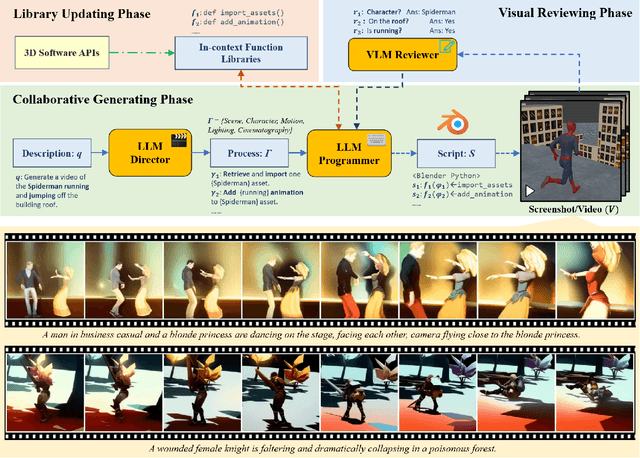

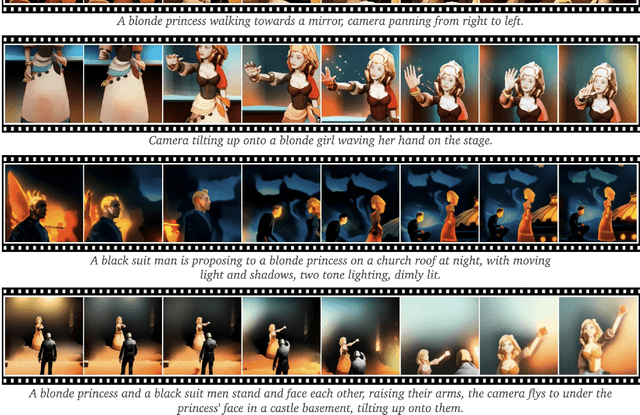
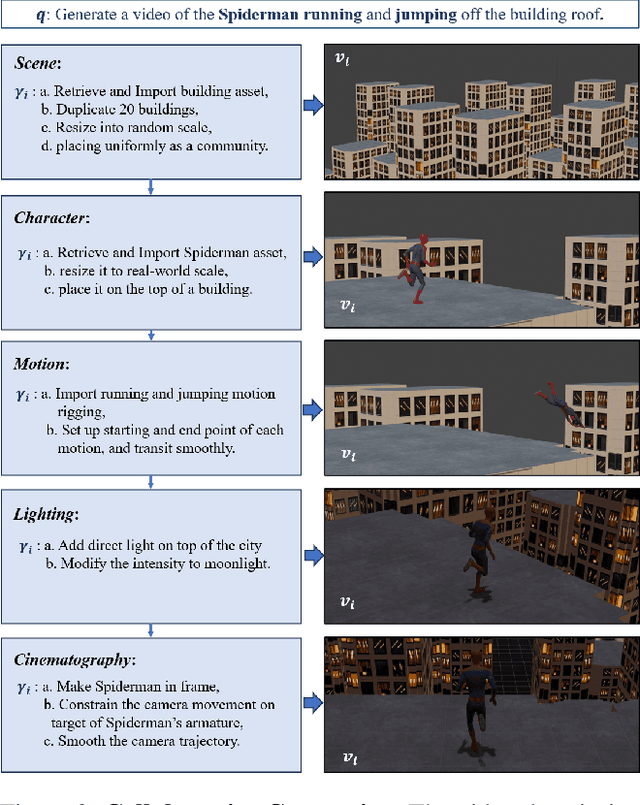
Abstract:Text-to-video generation has been dominated by end-to-end diffusion-based or autoregressive models. On one hand, those novel models provide plausible versatility, but they are criticized for physical correctness, shading and illumination, camera motion, and temporal consistency. On the other hand, film industry relies on manually-edited Computer-Generated Imagery (CGI) using 3D modeling software. Human-directed 3D synthetic videos and animations address the aforementioned shortcomings, but it is extremely tedious and requires tight collaboration between movie makers and 3D rendering experts. In this paper, we introduce an automatic synthetic video generation pipeline based on Vision Large Language Model (VLM) agent collaborations. Given a natural language description of a video, multiple VLM agents auto-direct various processes of the generation pipeline. They cooperate to create Blender scripts which render a video that best aligns with the given description. Based on film making inspiration and augmented with Blender-based movie making knowledge, the Director agent decomposes the input text-based video description into sub-processes. For each sub-process, the Programmer agent produces Python-based Blender scripts based on customized function composing and API calling. Then, the Reviewer agent, augmented with knowledge of video reviewing, character motion coordinates, and intermediate screenshots uses its compositional reasoning ability to provide feedback to the Programmer agent. The Programmer agent iteratively improves the scripts to yield the best overall video outcome. Our generated videos show better quality than commercial video generation models in 5 metrics on video quality and instruction-following performance. Moreover, our framework outperforms other approaches in a comprehensive user study on quality, consistency, and rationality.
COHO: Context-Sensitive City-Scale Hierarchical Urban Layout Generation
Jul 16, 2024Abstract:The generation of large-scale urban layouts has garnered substantial interest across various disciplines. Prior methods have utilized procedural generation requiring manual rule coding or deep learning needing abundant data. However, prior approaches have not considered the context-sensitive nature of urban layout generation. Our approach addresses this gap by leveraging a canonical graph representation for the entire city, which facilitates scalability and captures the multi-layer semantics inherent in urban layouts. We introduce a novel graph-based masked autoencoder (GMAE) for city-scale urban layout generation. The method encodes attributed buildings, city blocks, communities and cities into a unified graph structure, enabling self-supervised masked training for graph autoencoder. Additionally, we employ scheduled iterative sampling for 2.5D layout generation, prioritizing the generation of important city blocks and buildings. Our approach achieves good realism, semantic consistency, and correctness across the heterogeneous urban styles in 330 US cities. Codes and datasets are released at https://github.com/Arking1995/COHO.
 Add to Chrome
Add to Chrome Add to Firefox
Add to Firefox Add to Edge
Add to Edge